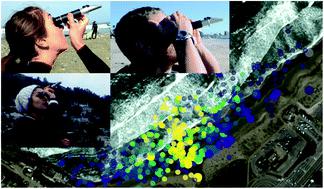当前位置:
X-MOL 学术
›
Environ. Sci.: Processes Impacts
›
论文详情
Our official English website, www.x-mol.net, welcomes your
feedback! (Note: you will need to create a separate account there.)
Participatory science for coastal water quality: freshwater plume mapping and volunteer retention in a randomized informational intervention.
Environmental Science: Processes & Impacts ( IF 4.3 ) Pub Date : 2020-04-29 , DOI: 10.1039/c9em00571d Wiley C Jennings 1 , Sydney Cunniff , Kate Lewis , Hailey Deres , Dan R Reineman , Jennifer Davis , Alexandria B Boehm
Environmental Science: Processes & Impacts ( IF 4.3 ) Pub Date : 2020-04-29 , DOI: 10.1039/c9em00571d Wiley C Jennings 1 , Sydney Cunniff , Kate Lewis , Hailey Deres , Dan R Reineman , Jennifer Davis , Alexandria B Boehm
Affiliation

|
Among the biggest threats to coastal water quality are freshwater discharges. It is difficult to predict the spatial extent of freshwater plumes at marine beaches because processes governing mass transport in the surf zone are complex. Participatory science approaches could facilitate collecting shoreline data, although volunteer sampling campaigns can be challenged by data quality and volunteer retention. The goals of this study were to (1) work with volunteers to estimate safe swimming distances at beaches that receive polluted discharges, and (2) test whether informational feedback to volunteers increased retention. Forty-six volunteers participated over 12 weeks in 2019 by collecting 1452 salinity measurements at beaches near the mouths of two Central California freshwater discharges and completing participation surveys. These measurements resulted in 145 distinct estimates of safe swimming distances (D90), spanning a range of environmental conditions during rainy and dry periods. Median D90s were 150 and 100 m at San Pedro Creek south and north, and 490 and 330 m at San Lorenzo River west and east, respectively. D90 was significantly associated with adjacent freshwater discharge rate at both discharges and tide level at one discharge. On average, the odds of volunteers conducting sampling decreased by 4% (95% CI: 1%, 7%) with each successive week. A randomized intervention providing repeated data feedback via email to volunteers did not affect their retention in the study.
中文翻译:

沿海水质的参与性科学:淡水羽流图绘制和自愿信息干预中的志愿者留存。
对沿海水质的最大威胁是淡水排放。很难预测海洋海滩上淡水羽流的空间范围,因为控制冲浪区大众运输的过程很复杂。参与式科学方法可能有助于收集海岸线数据,尽管志愿者采样活动可能会受到数据质量和志愿者保留的挑战。这项研究的目的是(1)与志愿者合作,以评估在受到污染的排放物的海滩上的安全游泳距离,以及(2)测试对志愿者的信息反馈是否增加了保留率。2019年,共有46名志愿者参加了为期12周的活动,他们在加利福尼亚中部两个淡水排放口附近的海滩上收集了1452个盐度测量值,并完成了参与度调查。这些测量结果得出145个不同的安全游泳距离(D90)估计值,涵盖了多雨和干旱时期的一系列环境条件。在圣佩德罗河以南和北部,D90的中位数分别为150 m和100 m,在圣洛伦佐河以西和东部,D90的中位数分别为490和330 m。D90与两次排放的相邻淡水排放率和一次排放的潮汐水位显着相关。平均而言,每周进行抽样调查的志愿者的几率降低4%(95%CI:1%,7%)。通过电子邮件向志愿者提供重复数据反馈的随机干预措施不会影响其在研究中的保留率。在圣佩德罗河以南和北部,D90的中位数分别为150和100 m,在圣洛伦佐河以西和东部,D90的中位数分别为490和330 m。D90与两次排放的相邻淡水排放率和一次排放的潮汐水位显着相关。平均而言,每周进行抽样调查的志愿者的几率降低4%(95%CI:1%,7%)。通过电子邮件向志愿者提供重复数据反馈的随机干预措施不会影响其在研究中的保留率。在圣佩德罗河以南和北部,D90的中位数分别为150 m和100 m,在圣洛伦佐河以西和东部,D90的中位数分别为490和330 m。D90与两次排放的相邻淡水排放率和一次排放的潮汐水位显着相关。平均而言,每周进行抽样调查的志愿者的几率降低4%(95%CI:1%,7%)。通过电子邮件向志愿者提供重复数据反馈的随机干预措施不会影响其在研究中的保留率。
更新日期:2020-02-21
中文翻译:

沿海水质的参与性科学:淡水羽流图绘制和自愿信息干预中的志愿者留存。
对沿海水质的最大威胁是淡水排放。很难预测海洋海滩上淡水羽流的空间范围,因为控制冲浪区大众运输的过程很复杂。参与式科学方法可能有助于收集海岸线数据,尽管志愿者采样活动可能会受到数据质量和志愿者保留的挑战。这项研究的目的是(1)与志愿者合作,以评估在受到污染的排放物的海滩上的安全游泳距离,以及(2)测试对志愿者的信息反馈是否增加了保留率。2019年,共有46名志愿者参加了为期12周的活动,他们在加利福尼亚中部两个淡水排放口附近的海滩上收集了1452个盐度测量值,并完成了参与度调查。这些测量结果得出145个不同的安全游泳距离(D90)估计值,涵盖了多雨和干旱时期的一系列环境条件。在圣佩德罗河以南和北部,D90的中位数分别为150 m和100 m,在圣洛伦佐河以西和东部,D90的中位数分别为490和330 m。D90与两次排放的相邻淡水排放率和一次排放的潮汐水位显着相关。平均而言,每周进行抽样调查的志愿者的几率降低4%(95%CI:1%,7%)。通过电子邮件向志愿者提供重复数据反馈的随机干预措施不会影响其在研究中的保留率。在圣佩德罗河以南和北部,D90的中位数分别为150和100 m,在圣洛伦佐河以西和东部,D90的中位数分别为490和330 m。D90与两次排放的相邻淡水排放率和一次排放的潮汐水位显着相关。平均而言,每周进行抽样调查的志愿者的几率降低4%(95%CI:1%,7%)。通过电子邮件向志愿者提供重复数据反馈的随机干预措施不会影响其在研究中的保留率。在圣佩德罗河以南和北部,D90的中位数分别为150 m和100 m,在圣洛伦佐河以西和东部,D90的中位数分别为490和330 m。D90与两次排放的相邻淡水排放率和一次排放的潮汐水位显着相关。平均而言,每周进行抽样调查的志愿者的几率降低4%(95%CI:1%,7%)。通过电子邮件向志愿者提供重复数据反馈的随机干预措施不会影响其在研究中的保留率。











































 京公网安备 11010802027423号
京公网安备 11010802027423号